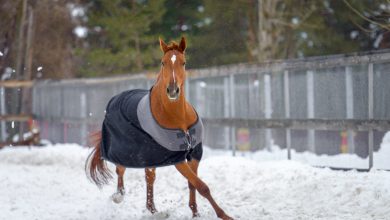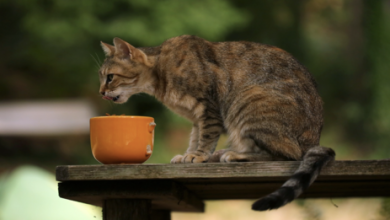What a Pain in My Neck! And Back…and Hocks.

This article is part of our Navigating Equine Arthritis Awareness Campaign, brought to you by American Regent Animal Health.
Have you ever woken up with a pain in your neck that you just can’t shake? Or maybe you tweaked your back, and it’s all you can focus on the entire day. Your horse isn’t immune to these types of pain, either. And arthritis or injury can leave your horse in discomfort, and not performing to his best level. Let’s take a look at how neck, back, and hock pain or arthritis can impact your horse, by looking back through the archives of Horse&Rider’s contributing veterinarian, Dr. Barb Crabbe, DVM.

The Neck Structure
Seven cervical vertebrae make up your horse’s neck, extending from his poll to his chest. These are at attachment points at two locations. One between the actual body of the vertebrae, cushioned by the intervertebral disks, and another between bony processes that extend along the vertebral top and sides (the articular facets).
The spinal cord is protected as it runs through a canal within the middle of these vertebrae. It functions to relay messages from the brain to the peripheral nerves that supply the rest of the body. Eight cervical nerves extend from the spinal cord, through foramen or openings at the side of each vertebral junction. The sixth, seventh, and eighth cervical nerves contribute to the brachial plexus, an intersection of all of the nerves that supply the forelimbs.
Pain in the Neck
If your horse is suffering from neck pain, it’s most likely from trauma; like a fall, pulling back, or flipping over. Sometimes neck issues can be present at birth. In some horses, arthritis in the neck is simply the result of long-term wear and tear. And in many cases there’s no history of trauma when a horse is diagnosed. Either way, neck pain can cause your horse to present with a variety of symptoms.
These symptoms can include a horse that is uncoordinated, lameness in the forelimbs, poor neck mobility, abnormal head position, and behavioral problems. A horse that is hurting often acts out of character and might suddenly start behaving.
[Read: Combating Arthritis After an Injury]So you suspect the neck. How can you find out what’s really wrong? The first and most important part of diagnosing a neck problem is the clinical neurological exam. Your vet will most likely palpate your horse, and a skin sensation test. Then they will probably perform a placement test, (your vet will pick up your horse’s feet one at a time and put them down in an abnormal position. If your horse is normal, he’ll immediately reset his foot where it belongs.) And typically your vet will complete a movement test. They will observe your horse moving in tight circles, up and down hills, backing up, and freely in a round pen or paddock. A horse with a spinal-cord problem may have difficulty placing his feet when circling, swinging his outside leg wide (known as circumduction); he also may step on himself.
The Deal with Back Pain
Your horse’s back health is paramount to his overall well-being. He can’t efficiently carry you into the show ring, down the trail, or on an enjoyable ride if his back is hurting.
Weakness and instability of your horse’s spine eventually can lead to arthritis in the small facet joints between the vertebrae. Arthritis in these tiny joints will cause the back to become stiff and painful. Nuclear scintigraphy, radiographs, and ultrasound may all play a part in making a diagnosis, which can be difficult. And treatment is challenging; like kissing spines, back arthritis easily can become a chronic performance-limiting problem if left untreated.
There are a few ways to help avoid back issues that aren’t caused by trauma or conformation. These include, proper saddle fit, balanced riding, proper warm-up and cool down, and equine bodywork.
Hock Function and Pain
Your horse’s hock is at once his most powerful and vulnerable joint. A horse that can use his hocks well can run faster, jump higher, pull harder, and stop quicker. But if your horse’s hock is hurting, his performance potential plummets. And, unfortunately, because the it’s such a complex joint, there’s a lot that can go wrong. First, it’s important to understand what it is and how it works.
The anatomy of the hock is complex, and it contains the tibio tarsal joint, the proximal and distal intertarsal joints, the tarso metatarsal joint, and the durable joint capsule that suspends the joint fluid in each respective joint space.
Signs of hock arthritis or pain can include shifting weight, changes in gait, reluctance to engage the hind end, resistance to going downhill, and heat or swelling. If your horse is experiencing hock discomfort, he can’t engage his hind end properly, and again, you might notice behavioral changes.
Treatment Options
The first step is to have your vet take a look if you suspect pain. Treatment options will depend on the results of diagnostic tests—and can have variable success. If arthritis of the articular facets is identified, your vet may suggest injecting those joints with a corticosteroid to help quiet inflammation. These injections were rarely performed in years past, but are now becoming fairly routine. They’re typically performed with ultrasound guidance, and can be effective in eliminating pain for a period of time.
Supplements that support joint health can also be an effective treatment strategy. As can proper exercise regimes, appropriate movement, comfortable environments, equine bodywork, and adequate rest. What’s the best answer for managing your horse’s arthritis or pain? Recognize and take care of problems that are likely to arise throughout his life—before they progress to something serious.



